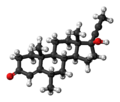Dimethisterone: Difference between revisions
CSV import Tags: mobile edit mobile web edit |
CSV import |
||
| Line 27: | Line 27: | ||
{{medicine-stub}} | {{medicine-stub}} | ||
<gallery> | |||
File:Dimethisterone.svg|Dimethisterone | |||
File:Dimethisterone_3D_ball.png|Dimethisterone 3D ball | |||
</gallery> | |||
Latest revision as of 01:51, 17 February 2025
Dimethisterone is a synthetic progestogen that belongs to the group of medications known as progestins. It is a derivative of testosterone, specifically a 17α-ethylated derivative of testosterone, which was developed in the 1950s and has been used in a variety of clinical applications. Dimethisterone has been utilized in the treatment of gynecological disorders, as a component of menopausal hormone therapy, and in some formulations of oral contraceptives. Despite its historical usage, it is less commonly used today, with other progestins being preferred for most therapeutic applications.
Medical Uses[edit]
Dimethisterone has been used in the treatment of various gynecological conditions, including endometriosis, amenorrhea, and to counteract the effects of estrogen in hormone replacement therapy, particularly in menopausal women. It has also been used in the past as a component of some oral contraceptive pills. However, its use in current medical practice is limited due to the availability of newer progestins with better efficacy and safety profiles.
Pharmacology[edit]
Mechanism of Action[edit]
As a progestin, dimethisterone acts by mimicking the effects of the natural hormone progesterone. It binds to and activates progesterone receptors in various tissues throughout the body, leading to a range of effects including suppression of ovulation, changes in the endometrium that prevent implantation of a fertilized egg, and thickening of the cervical mucus to inhibit sperm penetration.
Pharmacokinetics[edit]
The pharmacokinetic properties of dimethisterone, such as its absorption, distribution, metabolism, and excretion, are not well-documented in the current literature. Like other orally active progestins, it is assumed to undergo extensive first-pass metabolism in the liver.
Adverse Effects[edit]
The adverse effects of dimethisterone are similar to those of other progestins and may include nausea, headache, breast tenderness, and mood changes. Long-term use of progestins has been associated with an increased risk of certain conditions, such as cardiovascular disease and breast cancer, although the risk varies depending on the specific progestin and the patient's overall health profile.
History[edit]
Dimethisterone was developed in the 1950s as one of the first synthetic progestins. Its development marked a significant advancement in the field of hormonal contraception and hormone replacement therapy. Despite its historical significance, the use of dimethisterone has declined over the years in favor of newer, more effective progestins.
Society and Culture[edit]
The introduction of dimethisterone and other synthetic progestins had a profound impact on women's health, offering new options for contraception and the management of gynecological disorders. However, the use of dimethisterone has decreased over time due to the development of newer medications with improved safety and efficacy profiles.
-
Dimethisterone
-
Dimethisterone 3D ball


